IT 116: Introduction to Scripting
Class 12
Today's Topics
Tips and Examples
Review
New Material
Homework 6
I have posted homework 6 here.
It is due this coming Sunday at 11:59 PM.
Mid-term
The mid-term exam will be given on Tuesday, October 22nd.
It will consist of questions like those on the quizzes along with questions
asking you to write short segments of Python code.
60% of the points on this exam will consist of questions from the Ungraded Class Quizzes.
The other 40% will come from four questions that ask you to write a short segment of code.
The last class before the exam, Thursday, October 17th, will be a review session.
You will only be responsible for the material in the Class Notes for that class on the exam.
The Mid-term is a closed book exam.
To prevent cheating, certain rules
will be enforced during the exam.
Script Requirements for Functions
The new homework assignment requires you to define functions
When you write these function you must pay attention to the
Script Requirements
Some of these requirements apply to functions.
- Function names must be a good description of what the function does
- Every function must have a comment before the header which describes what the function does.
- All function definitions must must appear at the top of the script
- The function body must contain no blank lines
- All functions definitions must have a blank line between them
- The code that runs the functions must appear at the bottom of the page
after all functions have been defined
- There must be a blank line between the last function definition and the code that runs the function
- The code below shows what I mean
# this program prints some information about me
# prints the address of our campus
# prints the address of UMB
def print_umb_address():
print("University of Massachusetts at Boston")
print("100 Morrissey Boulevard")
print("Boston, Massachusetts 02125-3393")
# prints some information about me
def print_personal_info():
print('Glenn Hoffman')
print('Information Technology Program Director')
print('Computer Science Department')
print('University of Massachusetts at Boston')
print('Glenn.Hoffman@umb.edu')
print('Science 3-92A')
print("Some information about me")
print()
print_personal_info()
print()
print_umb_address()
Tips and Examples
Writing Python Scripts with a Text Editor
- Writing scripts can be frustrating
- If you misspell a variable name leave out a colon (:)
you will get an error
- In some programming courses students write scripts using special programs Integrated Development Environments
- Or IDEs
- IDEs have features that automate some routine tasks
- They can also check for certain kinds of errors
- PyCharm is one popular IDE for Python
- They are great for people who already know Python
- But they can be a crutch
- If you cannot write Python scripts without some special program, you become dependent on it
- You will be crippled if you need to write a script quickly in some new environment
- An IT person who can't write Python without an IDE is like an outdoor guide who can't find his or her way without a GPS
- Wherever you go you will always find a text editor
- But you may not find your favorite IDE
The Command Line
- The command line is not a user friendly environment
- You might even call it user hostile
- But most serious computer problems can only be fixed at the command line
- If you want to be an IT professional you need to know your way around the command line
- That is why I insist that you use the command line in this course
- There are some problems that can be fixed using a program with nice Graphical User Interface
- But most cannot
- If you want do well in IT you need to get your hands dirty
- You need to learn to use the command line
Colorizing nano
- One way you can make writing Python scripts easier without using an IDE is to enable
syntax highlighting
- This feature makes words in Python appear in different colors depending on their meaning in the code
- Colorizing
is another name for this feature
- Here is how ex9.py appears in
nano
when colorizing is turned on
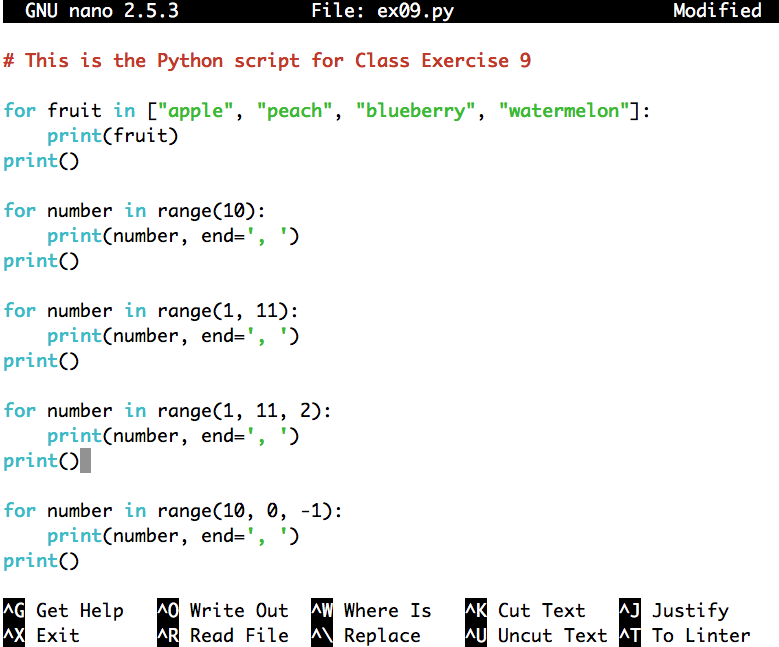
- Notice that comments appear in red
- String literals appear in green
- And keywords appear in cyan
- To turn on colorizing in
nano you need to do the following
- Doing this will enable colorizing for files with the .py extension
- As well as Perl, PHP, bash and HTML files
- Files have the right extension for colorizing to work
Review
Calculation a Running Total
- A total that is updated as new numbers are encountered
is called a running total
- A good example of a running total is a bank balance
- Your bank balance is the running total
of all deposits and withdrawals from your account
- In programming, running totals are computed using two features
- A variable that holds the total, called the
accumulator
- And a loop in which new numbers are added to the accumulator
- Before you enter the loop, the accumulator must be set to 0
- Running totals are used when you calculate averages
$ cat average.py
# this program asks the user how many numbers
# they have to enter, then performs a running
# total and computes the average
entries = int(input("How many entries? "))
total = 0
for entry_no in range(entries):
number = int(input("number: "))
total += number
average = total / entries
print("Average", average)
$ python3 average.py
How many entries? 10
number: 10
number: 9
number: 8
number: 7
number: 6
number: 5
number: 4
number: 3
number: 2
number: 1
Average 5.5
Augmented Assignment Operators
- In programming, we often have to change the value of a variable by some amount
- If we wanted to add 5 to the variable number we could write
number = number + 5
- Statements like this happen all the time
- So most computer programs have a special operator that you can use for such situations
- Instead of writing the statement above we could write
number += 5
- This operator works as follows
- Get the current value of the variable on the left
- Get the current value of the expression on the right
- Add the two values
- Assign this new value to the variable
- Using this operator makes the code shorter which reduces the risk of errors
- An operator like this is called an
augmented assignment operator
- because it does more than assign a value to a variable
- Python has an augmented assignment operator for every arithmetic operator
| Operator | Example | Equivalent To |
| += |
num += 5 |
num = num + 5 |
| -= |
num -= 5 |
num = num - 5 |
| *= |
num *= 5 |
num = num * 5 |
| /= |
num /= 5 |
num = num / 5 |
| //= |
num //= 5 |
num = num // 5 |
| %= |
num %= 5 |
num = num % 5 |
| **= |
num **= 5 |
num = num ** 5 |
Functions
- A function
is a group of statements that has a name and performs a specific task
- The Python interpreter has a number of functions that you can use without doing anything special
- They are called
built-in functions
- They are written inside the Python interpreter
- You can define your own Python functions
- Most Python scripts have a number of functions inside them
- You can also create files with a number of useful functions
called modules
- If you want to use module functions in a script you need an
import statement at the top
import MODULE_NAME
- The module name is the filename without the .py extension
- If you create a module you have to let the interpreter know where to find it
- On Mac and Unix you do this by setting the
PYTHONPATH system variable
- This variable tells the interpreter where to look for the modules you create
Using Functions in Writing Programs
- The idea of breaking a big job into smaller tasks
is one of the most important ideas in engineering
- The formal name for this process is modularization
- But it is often referred to as "divide and conquer"
- In programming, each specific task should have its own function
- This approach has many advantages
- Programs that are broken up into functions are easier to read
- Modularized programs are usually shorter because you write a function once then use it many times
- Modularization makes programs easier to test because you can test each function individually
- Modularization also makes it easier to work in teams
- Because you can assign different functions to different people
Two Types of Functions
- There are two types of functions
- Functions that return a value
- Functions that do not return a value
- The textbook calls the second type of function a
void function
- The conversion functions like
str, int and float
are examples of functions that return a value
- An example of a function that does not return a function is
print
- It causes something to be printed, but it doesn't return a value
Function Names
Defining a Function
Calling a Function
- To run a function run you write a
function call
- A function call has two parts
- The function name
- A list of arguments enclosed in parentheses
- You must follow the function name with parentheses even if the function takes no arguments
- The Python interpreter process a script statement by statement
- After a statement is processed, the interpreter forgets all about it
- Functions must be defined before they are used otherwise the interpreter will not be able to call them
- When the interpreter comes upon a function definition it stores it in a special place in memory
- When the interpreter comes across a function call it goes to that special memory location
- And executes the code block, statement by statement
- The function ends when the last statement in the code block is run
- Then interpreter returns to the line in the script where the function was called
New Material
Top Down Design
- The best way to work on a large project is to break it down into smaller tasks
- These smaller tasks can also be broken up until each task is manageable
- Programmers use this technique when writing large programs
- This technique is called top down design
- The basic approach is as follows
- Define the problem
- Break down the problem into smaller tasks
- Break down the smaller tasks into still smaller tasks
- Continue doing this until all tasks are as simple as possible
- Write functions for each of the smaller tasks
- Write a main program that calls all the functions
Example of Top Down Design
- Let's say you want to build a suspension bridge
- This is a very big project but if we break it down in smaller tasks it becomes more manageable
- Out first attempt at this might look like this
- Erect the towers
- String the cables
- Lay down the roadway
- But each of these tasks could be broken down further
- For example, erecting the towers can be broken down into
- Build the foundations
- Build the towers
- Stringing the cables could be broken down into
- Create anchorages on each bank of the river
- String the first line between the anchor points and the towers
- Run the cables from bank to bank for each cable
- Laying down the roadway can be broken down into
- Run stringers from the cable to the height of the roadway
- Erect a platform to hold the roadway suspended from the stringers
- Put a paved surface on top the the platform
- Each subtask can be broken down further
- For example building the foundation can be broken down into
- Erect a coffer dam
- Pump out the water
- Clear the bottom of mud and rubble
- Pour concrete
- With each breakdown we get closer and closer to a manageable task
- And each task can be given to a specific group of people
- Often these people can work in isolation from the rest of the project
The Advantages of Isolation
- If we are smart in how we break up the problem, each task will be independent
- It will not depend too much on the work of other teams
- That means each team can do their job without worrying about the rest of the project
- One part of building a bridge is constructing the anchors
- These massive concrete structures that hold the suspension cables taught
- There is one on either side of the river
- The teams working on the anchors not have to worry about other parts of the work
- Like the construction of the towers in the river
- Things work best when each team does is as independent of the work of others as possible
- If teams had to keep talking to one another as they worked
it would slow things down considerably
- Isolating the work of one group allows that group to keep working
- Even if other groups run into a problem
Specifying the Work for a Function
- Before you write a function you should be clear what the function should do
- Sometimes you write this out as a formal specification
- More often it is a short description in a comment before the function
- Here are comments from some of the functions I have written for use in other scripts
- converts a string into a decimal, if it can, otherwise returns the empty string
- prints an error message, then quits
- adds spaces to a string until its length is equal to the parameter given
- converts a string into an integer if it can, otherwise prints an error and quits
Keep It Simple
- One of the best ideas in engineering goes by the acronym KISS
- It stands for Keep It Simple Stupid
- Which do you think will break first?
- A machine with 10 parts or one with 100?
- The simpler something is, the less there is to go wrong
- The KISS principle says that a function should do one thing but do it well
- The more complicated you make a function, the harder it is to get it to work
Running Programs and the Operating System
- There is a special part of the operating system that deals directly with hardware
- Things like the processor, RAM and discs
- This program is called the
kernel
and it is always running in RAM
- Programs need interact with the hardware
- They need to read from a file
- Or created directories
- They cannot do this by themselves
- Instead they have to ask the kernel to do it for them
- When you are working at the command line you are running a special type of program called the
shell
- The shell allows you to ask the kernel to run a program for you
- A running program is called a
process
- And it has it's own bit of memory
- No other program can use this memory and this keeps programs from interfering with each other
- Every time you run a Python script that script is running in its own bit of RAM
How the Interpreter Uses Process Memory
- The Python interpreter runs inside the RAM for the script process
- It goes through the lines of the script statement by statement
- When it comes across a function definition it stores the code in a special part of the memory for the process
- When you create a variable in the body of the code, the value is stored somewhere else
- In another part of process memory
- When you call a function that function gets is own, separate piece of memory
- This chuck of process memory is used to store the function's variables
- It is separate from the memory where the function are stored
- The memory given to the function disappears when the function quits
- This means that the variable inside a function are not permanent
- Function memory disappears when the function finishes
- Giving each function its own space in memory keeps the function isolated from other parts of the script
Parameters
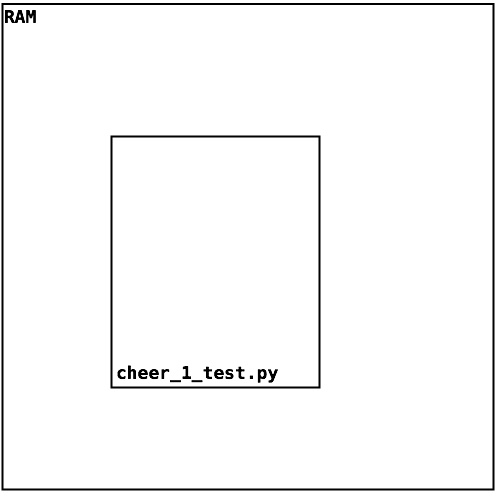
- The script cheer_1_test.py has process memory assigned to it
- The function has not been called, so there in no function memory
- When cheer_1 is called it gets its
own piece of memory for its variables
- The parameter team lives in this function memory
- team gets the value "Red Sox" from the function call
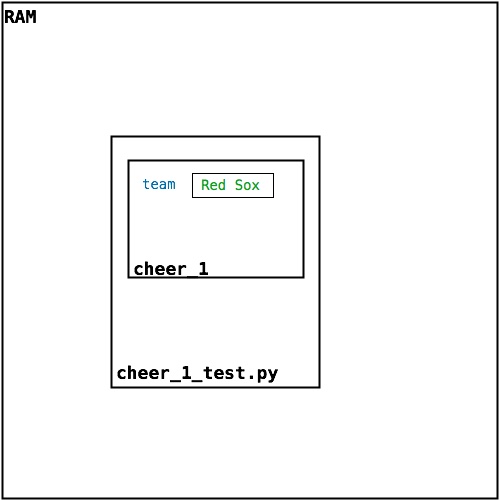
- After the function finishes it's memory disappears
- So all its variables are gone


- the script has declared the variable team in it's memory space
- When the function is called it gets it own variable memory space
- It uses this to create its own variable team
- This variable is different from the variable of the same name in the script's memory space
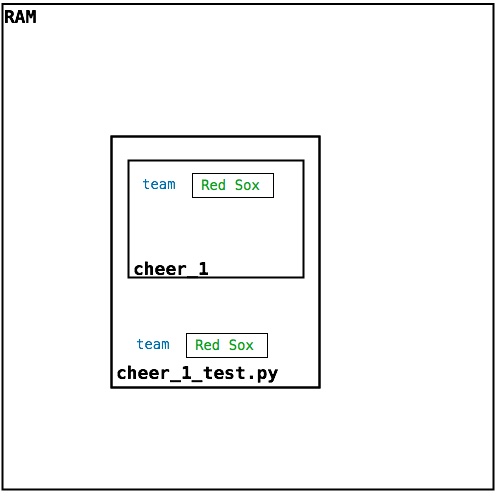
- When the function finishes, it gives up its memory space
- But the original variable team is still around
- It will not disappear until the script ends

Local Variables
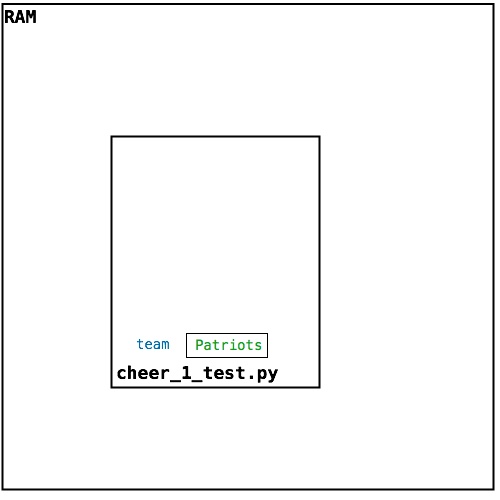
- Once again the script has a team variable
inside it's own memory space
- Now let's look at the situation after the function is called but before any of the function code is run
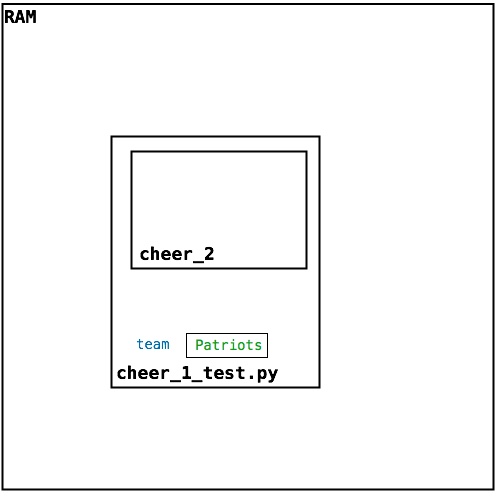
- The function has no parameter, so it has no variables of its own yet
- After the first line of the function is executed a local
team variable is created
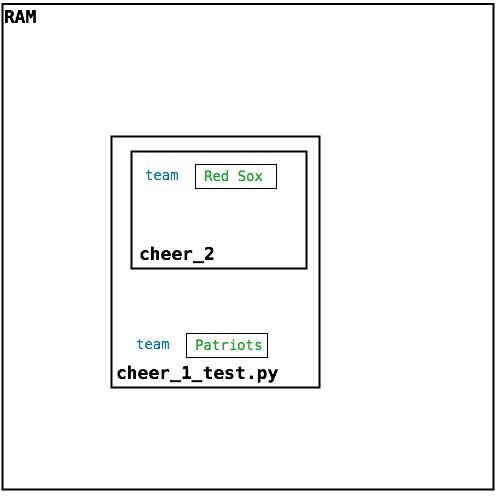
- Notice that we have two team variables with different values
- When the function finishes it loses it's memory space and all it's variables

- Now we are only left with the original team variable
- The part of a program where a variable has meaning is called the
scope of the variable
- Local variables defined inside one function are invisible outside the function
- This means we can use the same variable name in more than one function
Parameters Are Local Variables
- Parameters only come into existence inside the memory space of the function
- That means that parameters are local variables
- The only thing that makes a parameter different from other local variables it how it gets its first value
- It gets this value from an argument in the function call
- This value can be changed later, if you wish
Attendance










